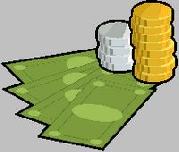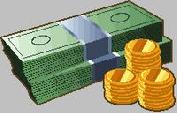
 |
|
| Financial Terms | |
| Run |
|
Information about financial, finance, business, accounting, payroll, inventory, investment, money, inventory control, stock trading, financial advisor, tax advisor, credit.
Main Page: inventory, tax advisor, accounting, investment, financial, business, finance, payroll, Also see related: home insurance, property, real estate, insurance, homes, financing, first time homebuyer, home, homebuyer, |
Definition of Run
RunA run consists of a series of bid and offer quotes for different securities or maturities. Dealers give to and
Related Terms:runupthe period before a formal announcement of a takeover bid in which one or more bidders are either preparing to make an announcement or speculating that someone else will. Book runnerThe managing underwriter for a new issue. The book runner maintains the book of securities sold. Long runA period of time in which all costs are variable; greater than one year. Long runA period of time in which all costs are variable; greater than one year. On the runThe most recently issued (and, therefore, typically the most liquid) government bond in a Short-run operating activitiesEvents and decisions concerning the short-term finance of a firm, such as economic production run (EPR)an estimate of the number  Credit CrunchA decline in the ability or willingness of banks to lend. OverrunA manufactured or received quantity exceeding the planned amount. BaneIn the words of Warren Buffet, Bill Bane Sr., is, "a great American and one of the last real traders Benchmark interest rateAlso called the base interest rate, it is the minimum interest rate investors will Benchmark issuesAlso called on-the-run or current coupon issues or bellwether issues. In the secondary CashoutRefers to a situation where a firm runs out of cash and cannot readily sell marketable securities. Current issueIn Treasury securities, the most recently auctioned issue. Trading is more active in current Expense ratioThe percentage of the assets that were spent to run a mutual fund (as of the last annual Forward looking multipleA truncated expression for a P/E ratio that is based on forward (expected)  J-curveTheory that says a country's trade deficit will initially worsen after its currency depreciates because Matched bookA bank runs a matched book when the distribution of maturities of its assets and liabilities are equal. Monte Carlo simulationAn analytical technique for solving a problem by performing a large number of trail PrivatizationThe act of returning state-owned or state-run companies back to the private sector, usually by Stockoutrunning out of inventory. Target payout ratioA firm's long-run dividend-to-earnings ratio. The firm's policy is to attempt to pay out a Unmatched bookIf the average maturity of a bank's liabilities is less than that of its assets, it is said to be GENERAL-AND-ADMINISTRATIVE EXPENSESWhat was spent to run the non-sales and non-manufacturing part of a company, such as office salaries and interest paid on loans. OPERATING EXPENSESThe total amount that was spent to run a company this year. SELLING EXPENSESWhat was spent to run the sales part of a company, such as sales salaries, travel, meals, and lodging for salespeople, and advertising. ExpensesCosts involved in running the company. Office suppliesThe cost of the supplies used in running an office. accounts payableShort-term, non-interest-bearing liabilities of a business accounts receivableShort-term, non-interest-bearing debts owed to a current assetsCurrent refers to cash and those assets that will be turned fixed expenses (costs)Expenses or costs that remain the same in amount, variable expensesExpenses that change with changes in either sales volume committed costa cost related either to the long-term investment discretionary costa cost that is periodically reviewed by a environmental constraintany limitation on strategy options expected capacitya short-run concept that represents the normal capacitythe long-run (5–10 years) average production setup costthe direct or indirect cost of getting equipment vision statementa written expression about the organization’s Monte-Carlo simulationA mathematical modeling process. For a model that Fixed costA cost that does not vary in the short run, irrespective of changes in any Perpetual inventoryA system that continually tracks all additions to and deletions Setup costThe cluster of one-time costs incurred whenever a production batch is run, Aggregate Supply CurveCombinations of price level and income for which the labor market is in equilibrium. The short-run aggregate supply curve incorporates information and price/wage inflexibilities in the labor market, whereas the long-run aggregate supply curve does not. Business CycleFluctuations of GDP around its long-run trend, consisting of recession, trough, expansion, and peak. Natural Rate of Unemployment (NRU)The level of unemployment characterizing the economy in long-run equilibrium, determined by the levels of frictional, structural, and institutionally induced unemployment. At this rate of unemployment, inflation should be constant, so it is sometimes called the nonaccelerating inflation rate of unemployment, or NAIRU. Neutrality of MoneyThe doctrine that the money supply affects only the price level, with no long-run impact on real variables. Permanent Income HypothesisTheory that individuals base current consumption spending on their perceived long-run average income rather than their current income. Purchasing Power ParityTheory that says that over the long run exchange rate changes offset any difference between foreign and domestic inflation. This result assumes that the real exchange rate remains constant, something that is not true even in the long run. Structural DeficitThe budget deficit in excess of the deficit that in the long run keeps constant the ratio of the publically held national debt to GDP. Mass customizationHigh-volume production runs of a product, while still offering Requirements explosionThe component-level requirements for a production run, Scrap factorAn anticipated loss percentage included in the bill of material and Related to : financial, finance, business, accounting, payroll, inventory, investment, money, inventory control, stock trading, financial advisor, tax advisor, credit. |